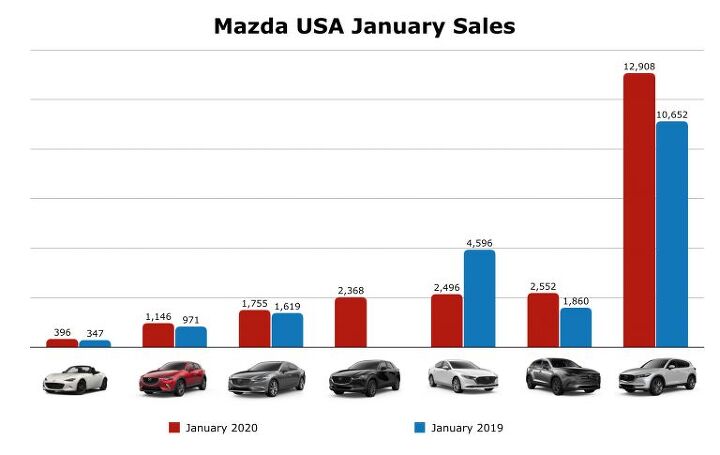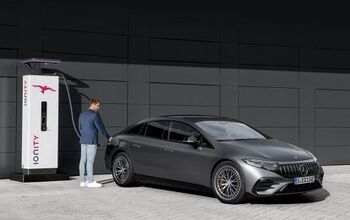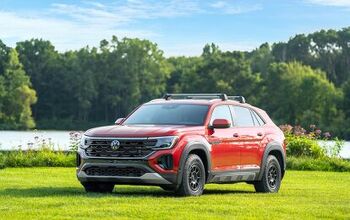Finally, Mazda Starts Off 2020 on the Right Foot With a U.S. Sales Surge - but the Mazda 3 Disaster Reaches New Proportions
Finally, Mazda appears to be on something of a roll. After U.S. volume at the underdog automaker tumbled to a seven-year low in 2019, January 2020 sales at Mazda jumped 18 percent.
Better yet, January marked the fourth consecutive month of year-over-year gains at Mazda, an essential turnaround for a marque that kicked off 2019 with seven consecutive months of decline. Over the last four months, Mazda’s U.S. sales actually grew by nearly 9,000 sales, a 10-percent uptick.
So, all is well? If Mazda sustains this level of volume growth over the next 11 months, Mazda would follow up its seven-year low from 2019 with a 26-year annual sales high.
The chance for major growth will most definitely fall on the shoulders of the new CX-30, because the fourth-generation Mazda 3’s tragically awful 2019 was followed up by a January in which the 3 rolled over and played dead.
Not since 1990 had sales of the Mazda 3 (or its predecessors) fallen to such low levels. Despite obvious improvements, all-wheel-drive availability, and a shrinking pool of small-car rivals, only 50,741 copies of the 3 found homes in the U.S. in 2019. Mazda’s upmarket intentions, most obviously evidenced by the departure of the 3’s entry-level engine, were partly to blame for Mazda 3 sales falling to less than half of 2015’s output. Compared with an already disappointing 2018, Mazda 3 sales last year were down by more than a fifth.
Now, compared to that dreadful kickoff in 2019, Mazda 3 sales in January 2020 plunged even further, tumbling by nearly half to only 2,496 units. January’s Mazda 3 total fell nearly 1,000 units shy of 2019’s worst monthly total. (Over the last decade, the Mazda 3’s January tally has averaged over 6,800 units.)
Yet every other vehicle in the Mazda lineup – yes, even the Mazda 6 – reported significant year-over-year improvements in January 2020. Excluding the 3 and new CX-30, Mazda sales were up 21 percent thanks to an 18-percent CX-3 rise, a 21-percent CX-5 increase, a 37-percent CX-9 improvement, an 8-percent Mazda 6 uptick, and 14-percent growth from the MX-5 Miata. It was the best January ever for both the CX-5 and CX-9.
It was, however, just January. Merely January. Only January. If ever there was a month on the auto sales calendar that didn’t matter, a month on which few theories could be based and scarcely any trends could be projected, January would be it. Not since 2008, when the year ended in recession, has January failed to secure its rightful position as the lowest-volume auto sales month in the United States. January will account for 8.5 percent of the year, but not likely 7 percent of the year’s auto sales.
Of course, we don’t need January 2020 to tell us that the latest Mazda 3 failed to launch. And we don’t need January to show us that the 3-based CX-30, with its elevated ride height and a starting price that makes it more affordable than the 3 hatchback, has a much better chance of success. Already, in an abbreviated early sales month with limited availability, the CX-30’s 2,368-unit output was very nearly enough to make the 3 Mazda’s No. 4 model. (Yes, the CX-5 and the CX-9 flagship outsold the 3, too.)
Following in the footsteps of more-spacious-than-subcompact small crossovers such as the Subaru Crosstrek and Nissan Rogue Sport, the CX-30 is aimed squarely at a gigantic bullseye that’d be hard for any automaker to miss. It’s a segment that, over the last half-decade, doubled in size and then doubled in size twice more. While the new Mazda 3, unlike the Honda Civic and Toyota Corolla, has proven incapable of gaining the upper hand in a small car segment suddenly devoid of domestic competition, the CX-30 is poised to join the CX-5 as a high-volume Mazda.
If so, Mazda’s January will be remembered as an effective harbinger.
If not, Mazda will look back and wonder how they bungled it, back to back.
[Images: Mazda]
Timothy Cain is a contributing analyst at The Truth About Cars and Driving.ca and the founder and former editor of GoodCarBadCar.net. Follow on Twitter @timcaincars and Instagram.
More by Timothy Cain
Latest Car Reviews
Read moreLatest Product Reviews
Read moreRecent Comments
- Teddyc73 Doesn't matter, out of control Democrats will still do everything they can to force us to drive them.
- Teddyc73 Look at that dreary lifeless color scheme. The dull grey and black wheels and trim is infecting the auto world like a disease. Americans are living in grey houses with grey interiors driving look a like boring grey cars with black interiors and working in grey buildings with grey interiors. America is turning into a living black and white movie.
- Jalop1991 take longer than expected.Uh-huh. Gotcha. Next step: acknowledging that the fantasies of 2020 were indeed fantasies, and "longer than expected" is 2024 code word for "not gonna happen at all".But we can't actually say that, right? It's like COVID. You remember that, don't you? That thing that was going to kill the entire planet unless you all were good little boys and girls and strapped yourself into your living room and never left, just like the government told you to do. That thing you're now completely ignoring, and will now deny publicly that you ever agreed with the government about.Take your "EV-only as of 2025" cards from 2020 and put them in the same file with your COVID shot cards.
- Jalop1991 Every state. - Alex Roy
- CanadaCraig My 2006 300C SRT8 weighs 4,100 lbs. The all-new 2024 Dodge Charge EV weighs 5,800 lbs. Would it not be fair to assume that in an accident the vehicles these new Chargers hit will suffer more damage? And perhaps kill more people?




































Comments
Join the conversation
Mazda is not a cohesive company and cannot control their dealerships
I've thought about this article more than any other in the past year. I own a 2017 3GT, and have had zero issues with it. Having said that, I feel for Mazda. It takes years to develop a new car, and when they finally got it ready, their target buyer (young person just out of college, or getting their first real job) can no longer afford a new car. The people who like styling, can afford only limited performance, and don't care much about the back seat, can't afford your car any more. So what do you do? You try to appeal to the group that has money (older people) with "premium" offerings. Unfortunately, that group has moved on en masse to CUV's, and excepting a few enthusiast types, aren't coming back. So putting the standard on only the top tier option group, while a dick-ish move, probably isn't a bad one business-wise. Two things a manufacturer of any product needs to keep in mind: 1) who is your target market, and 2) why do they buy your product? With Subaru or Jeep, it's the whole outdoors/capability thing. Mazda had Zoom-zoom at one time, but they seem to have let that lapse. Allowing the accountants talk you into a beam suspension, even if 99% of the owners never come close to the limits of a well-designed beam suspension, is foolish; see #2 above. So what could Mazda do to bring people back? this may seem trite, but there's one thing that occurred to me: Give me some freakin' color choices! I've gotten so tired of silver, black, white, maroon. If I could have a 3GT in British Racing Green, with a tan leather interior, I'd be there. Go to a business model where they have a few cars in the lot, and you order what you want. The only thing the current business model, where the dealer is the real customer, only gives you appliances. I'd like to be excited about a car again.